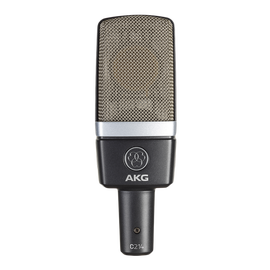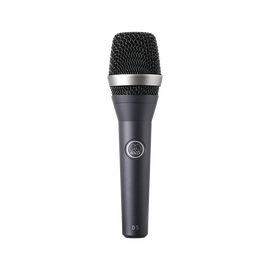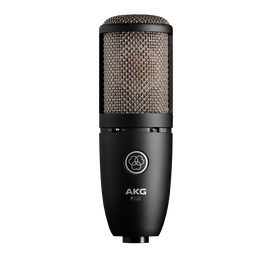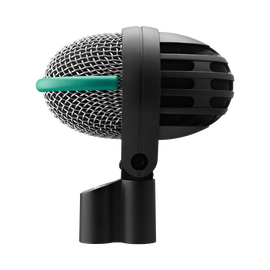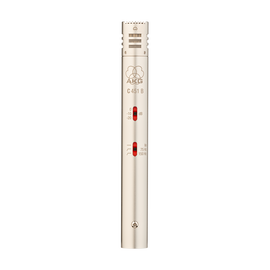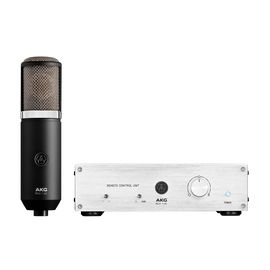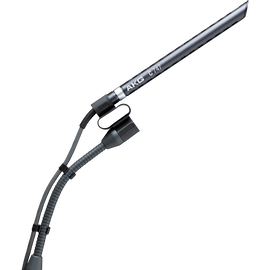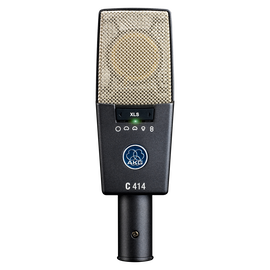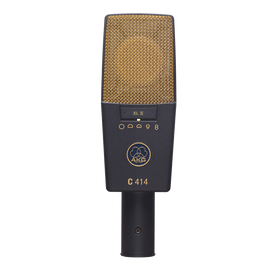
AKG Blog
How to choose the right microphone to record anything
By Sarah jones
When you’re in the studio, picking the right microphone for the job can feel pretty daunting. There are thousands of mics out there, and thousands more ways to use them all.
Choosing the right mic is more art than science, and involves trial and error. Getting to know the “sound” of the mics you own and learning how they perform in different scenarios are the first steps toward making professional-sounding recordings at home.

From versatile, multi-purpose mics like Lyra (above), to mics designed to record drum sets, AKG offers a wide range of microphones for all types of recording applications.
When choosing microphones, your number one consideration is sound quality. That said, it’s prudent to start by setting a budget and thinking about what you want to record. Will you be recording yourself or a band? Are you into acoustic music or heavy metal? Are you producing podcasts? Video content?
If you have the budget, it makes sense to build a collection of microphones designed for specific purposes. If your budget is limited (and really, whose isn’t?), choose multipurpose microphones designed to perform well in a range of scenarios. We’ll make that process a little easier by walking you through some of the most common microphone types and their uses. (This article focuses on microphones for recording, but many models here do double duty as stage mics.)
HOW MICROPHONES WORK
Microphones are transducers, which means they convert energy from one form (acoustic) to another (electrical). Microphones fall into two general categories: condenser and dynamic; both rely on a physical diaphragm to convert sound waves into electrical energy, aka your audio signal.
Dynamic Microphones
Dynamic microphones are based around a diaphragm attached to a metal coil suspended inside a magnetic field. When sound waves vibrate the diaphragm, the coil vibrates, generating an electrical signal.
Because dynamic microphones are simple in construction, they’re generally very durable and economical. They’re resistant to heat and humidity, can handle extreme sound pressure levels and are less sensitive than other microphones, which means they pick up direct sound without capturing a bunch of ambient noise. For these reasons they’re commonly used in sound reinforcement and to record loud sources such as drums and guitar amps. They’re great low-cost, all-purpose mics for general voice-recording applications like podcasting, for recording guitar amp cabinets, or for bands who want to get “that live sound” in the studio.

Condenser microphones, like AKG P420 (above), are more sensitive than dynamic mics and pick up finer sonic details (particularly high-frequencies and transient information), making them ideal for studio recording.
Condenser Microphones
Condenser microphones work on the principle of “variable capacitance”: Sound waves vibrate a conductive diaphragm mounted in front of a charged backplate, changing the capacitance of the back plate and converting acoustic energy to electrical energy. Condensers are more sensitive than dynamic mics and pick up finer sonic details (particularly high-frequency and transient information), making them ideal for studio recording.
Condenser mics are based on tube or solid-state electronics; because condensers contain active electronics, they require phantom power (DC current sent through an XLR microphone cable) to operate; this is supplied by a mixer, preamp, interface, external supply or batteries.
Condensers are loosely categorized as large-diaphragm (larger than about an inch in diameter) or small-diaphragm designs. (For now, we’ll skip specialty mics like shotguns and lavaliers.) Diaphragm size tends to inform a condenser mic’s construction: Small-diaphragm condensers are usually slim, pencil-shaped and end-fired, while large-diaphragm condensers are bulky and operate from a side-address orientation.
Large-diaphragm condensers are known for bringing a pleasing or “present” quality to any recorded source from vocals to strings, and are often available with multiple pickup patterns, making them great multipurpose microphones. They’re very sensitive and usually require both external power and suspension mounting to isolate them from external vibrations—which can be challenging when recording in tight spaces or close-miking drum kits.
Small-diaphragm condensers are known for capturing pure, transparent sound, and their small, low-mass diaphragms make them ultra-responsive to sound sources with sharp transients, such as acoustic guitar or cymbals.

AKG Lyra, which delivers Ultra-HD audio, includes a built-in headphone jack and lets you adapt its focus to capture a single speaker, one-on-one interviews or large groups.
USB Microphones
The popularity of computer-based recording has led to the proliferation of USB microphones. USB mics contain the elements of a traditional microphone but add a built-in preamp and analog-to-digital converter, enabling them to plug directly into a computer or mobile device. USB mics are low cost, plug-and-play simple and often have volume controls and other functions right on the mic.
If you love the convenience of a USB mic, check out the AKG Lyra Ultra-HD Multimode Microphone, which offers four selectable focus patterns that adapt to any source and features useful front-of-mic functions including mute and headphone volume.
DIRECTIONALITY
A microphone responds to sound in a three-dimensional space surrounding its capsule; it picks up sound coming from different directions with varying degrees of sensitivity, depending on mic style and design. A microphone’s pattern of directionality is its polar pattern: Understanding polar patterns is crucial for selecting a model that captures the sounds you want while minimizing those you don’t. (Note that polar patterns are frequency dependent and become more directional as frequencies rise.)

Omnidirectional mics pick up sound equally from all directions.
Omnidirectional Mics
An omnidirectional microphone picks up sound equally from all directions. By design, it exhibits “open” characteristics, with extended natural low-frequency response. Omnis are great for recording wide sources such as choirs, and for capturing performances in rooms with great acoustics. These same qualities make omnis unsuitable for noisy locations, unless you’re intentionally capturing location sound for podcasts, etc.
Unidirectional Mics
Unidirectional microphones pick up sound coming from a specific direction (axis), and are most sensitive at their fronts, minimizing sound arriving from other directions or “off axis.” (Because directional mics color sound captured off axis, mic position and technique are very important.)
Directional microphones exhibit a “proximity effect”: As a sound source gets closer to the microphone, low frequencies become more pronounced. This bass boost can be problematic, but it can also be used to creatively shape sound. We’ll take a look at the most common directional patterns:

Cardioid microphones pick up sound in a heart-shaped pattern; they’re most sensitive to the sounds in front of them and reject sound at the rear.
Cardioid microphones pick up sound in a heart-shaped pattern; they’re most sensitive to the sounds in front of them, tapering to attenuate sound arriving along the sides and reject sound at the rear. This front-focused pattern is the most popular microphone polar pattern, as it does a good job of isolating a sound source from unwanted ambient sounds. A cardioid mic’s ability to reject sound from the rear also makes it useful in multi-miking scenarios and situations where the goal is to minimize room sound.
Supercardioid and hypercardioid variations of the cardioid pattern exhibit the same front-forward directionality, with progressively narrower areas of sensitivity on the sides and a lobe of increased sensitivity at the back. (A supercardioid mic’s typical pickup angle is about 115 degrees, where a hypercardioid’s is closer to 105 degrees.) These patterns offer greater isolation at their sides and high resistance to feedback, making them ideal for loud sources and stage applications.

Supercardioid microphones exhibit the same front-forward directionality as cardioid microphones, with progressively narrower areas of sensitivity on the sides and a lobe of increased sensitivity at the back.
Bidirectional/Figure-8 Microphones
Bidirectional mics are sensitive at their front and back and reject sounds at their sides in a pattern that looks like a figure-8 with the mic capsule at the crossover point. Bidirectional mics are ideal for situations where you want to record two separate sound sources while blocking out others, such as duets, recording guitar and vocals together and advanced stereo-miking applications such as mid-side and Blumlein recording.

Bidirectional microphones are sensitive at their front and back and reject sounds at their sides.
Multipattern Microphones
Some mics feature dual diaphragms that can be combined in a variety of polar patterns, switchable between omni, cardioid and figure-8 and patterns in between. These versatile mics are true workhorses with endless applications.
WHICH MIC IS RIGHT?
Like everything in life, there are some basic rules for picking mics—though like many rules, these are meant to be broken. As a general practice, reach for dynamic mics for live situations, and condensers for recording—unless you’re recording very loud sounds, in which case bust those dynamics out!

AKG C414 imparts classic warmth and presence that contribute to a stunning track.
Vocals
Every singer is unique; a mic that sounds gorgeous on a jazz singer might not cut it for a metal artist. Often, the best vocal mic for the job adds some flattering coloration and character. Here, large-diaphragm condensers such as the AKG C214 and AKG C414 impart classic warmth and presence that will contribute to a stunning track. Don’t be afraid to try a cardioid dynamic—especially if you have a screamer in the studio. The rugged AKG D5 handheld dynamic features our patented Varimotion diaphragm for crystal-clear sound, with a supercardioid pattern for great isolation.

AKG P220 is a great option for recording guitar amps. It features an attenuation pad for when your guitarist really wants to crank it up.
Guitar Amps
This is a job for a dynamic cardioid mic, which can handle those high SPLs. Try adding a condenser placed further back to record reflected sound and room tone. A great option is the AKG P220, which features a switchable attenuation pad for those times when your guitarist wants to really crank it up to get that live feel. (If you have a multipattern condenser, give omni mode a try to capture even more room sound.)
Piano
Pianos generate sound across a wide physical space and frequency range and are usually recorded in stereo, with one mic on the low strings and another on the high strings. Although classical recordings capture a lot of ambient room sound, for pop music, close-miking is usually more appropriate. Omni mics will minimize exaggeration of specific areas in the instrument’s range, and small-diaphragm condensers are adept at capturing nuances in the high end. The AKG P420 dual condenser delivers warm, transparent sound perfectly suited for grand piano, and it’s also great on ensembles. With three selectable polar patterns, it’s an ideal tool for stereo miking and ambient recording.

From kick drum to hi-hat, the AKG Drum Set Concert I is a microphone suite allows you to mike your complete drumset and capture crystal-clear recordings.
Drums
There are endless ways to mic a drum kit, from placing a simple stereo pair overhead to putting individual mics on every drum. Try cardioid dynamic mics on the kit itself, perhaps mixing in some condensers on snare or toms and a small-diaphragm condenser on hi-hat; for overhead mics, try a pair of condensers. Try mics designed for specific drum-miking applications, such as the AKG D112 MkII kick drum mic. Take some of the guesswork out of choosing drum mics with AKG’s hand-selected drum mic bundles.

With an airy sound, high overload limit and low-noise preamp electronics, AKG C451 B is perfect for acoustic guitars or other instruments.
Acoustic Guitar and Other Instruments
Uncolored condenser microphones are ideal choices for almost any acoustic instrument. To capture the nuances of acoustic guitar, try small-diaphragm condensers; the AKG C451 B small-diaphragm condenser has an airy sound, high overload limit and low-noise preamp electronics. Try the AKG P170 instrument mic, a small-diaphragm condenser that shines on overheads, acoustic guitars and strings; its lightweight, half-inch diaphragm delivers outstanding clarity and transient response. Take your recordings to the next level with the AKG P820 Tube multipattern condenser, which features dual one-inch capsules and advanced ECC83 dual-triode circuitry and is excellent for highlighting brass (and lead vocals!).
Video Production
If you’re recording video and have the resources, consider investing in shotgun mics (the AKG C747 V11 is sleek and discreet and also works well on a variety of instruments) and lavalier mics. (Check out AKG’s full range of miniature mics here.) As an alternative, try condensers with selectable pickup patterns.

AKG C414XLS is a large-diaphragm, multipattern condenser that sounds great on just about anything from the softest whisper to monster guitars.
The All-Around Workhorse
If you can invest in only one microphone, a large-diaphragm multipattern condenser is the way to go. It’s incredibly versatile, a major value and sounds great on just about anything from the quietest whisper to monster guitars. AKG C414 XLS and C414 XLII multipattern condenser mics are modern studio classics: These multitasking wonders offer nine polar patterns and a range of highpass filters and pads that let you capture any source in brilliant clarity. (For a more affordable way to get into the AKG C Series, check out the C214 large-diaphragm condenser, which combines one capsule of the C414’s dual-capsule system with our patented back-plate technology.)
A great recording is the product of many factors, from the quality of the performance to the recording environment to mic selection and technique. We’ve provided some guidelines here, but the “right” mic for the job is subjective, and remember, rules were meant to be broken! Learn what your microphones bring to each recording scenario, don’t be afraid to experiment and you’ll be nailing perfect takes in no time.
Related products
AKG Blogs
9 pro tips for livestreaming your show from home
If you’re like most musicians, gigs are your lifeblood. But when you can’t connect with your audience in person, livestreaming is your best opportunity to gain new fans and generate income while building momentum for your next show.
Read MoreHow to Pick Professional Headphones for Any Scenario
What’s your most-used piece of audio gear? You probably don’t need us to tell you that it’s your headphones. Headphones provide a consistent audio reference in a variety of environments, they’re essential tools for evaluating the fine details in your mix—and they do it without annoying the neighbors.
Read MoreComparing digital & analog wireless mic systems
Since the release of AKG’s new DMS 100 and DMS 300 digital wireless systems, we’ve fielded lots of questions about the differences between digital and analog systems, so we thought it would be helpful to explain the benefits of each.
Read MoreHow to choose the right microphone to record anything
Choosing the right mic is more art than science, and involves trial and error. Getting to know the “sound” of the mics you own and learning how they perform in different scenarios are the first steps toward making professional-sounding recordings at home.
Read MorePro sound for work-at-home professionals
Whether your home office or classroom is temporary or permanent, HARMAN has affordable, easy-to-use tools that will help you communicate with clarity and focus on the task at hand.
Read More7 ways to sound better on a conference call
Conferencing services like Zoom, Skype and Webex bring familiar faces right to your screen—and chances are, conference calls are becoming a central part of your life right now.
Read MoreHow to get studio-quality sound from your smartphone with AKG Lyra
Whether you’re recording a podcast or voiceover, making field recordings, capturing audio inspiration on the go, or live streaming to your fans, nothing beats the convenience and portability of a smartphone.
Read MoreAKG DMS300 Digital Wireless Systems Earn High Praise from Performer Magazine
Wireless microphone systems have come a long way over the years, and the AKG DMS300 digital system is no exception. Once thought of as inferior to their wired counterparts, many wireless systems like DMS300 not only sound just as good—if not better—than wired systems.
Read More